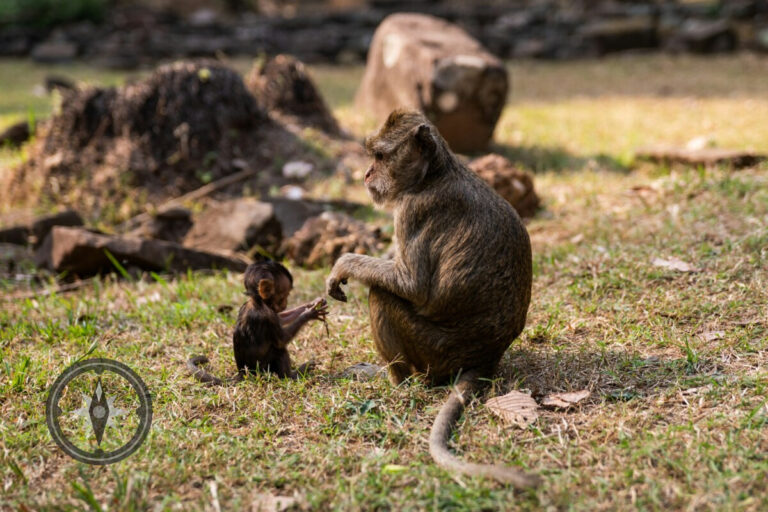Picture in your mind what Earth was like millions of years ago, human ancestors wandering around, crafting tools from twigs and leaves, not just by instinct, but through knowledge passed down from generation to generation. This ability to share behaviors, traditions, and ideas – what we call cultural transmission – is a defining characteristic of humanity, shaping our societies and propelling our progress. But where did this remarkable ability begin? And how has it evolved over time? This article delves into the fascinating journey that includes the tool-wielding crows of today and the language-wielding humans of the past. This narrative not only celebrates our achievements but also prompts us to reflect on the legacy we will leave for the generations that follow.
Although speculative, very simple cultural transmission likely started millions of years ago. Something like human cultural transmission likely started before 440,000 years ago, perhaps with the common ancestor of humans and Neanderthals. This idea is supported by discoveries over the last decade or so. Neanderthals had larger brains on average than us, they had symbolic thought, made art, and our understanding of human evolution has advanced. The timing is based on the growing body of evidence. That evidence places Homo heidelbergensis in Africa before 440,000 years and connected to humans in Africa on one branch, and Neanderthals in Europe on another.

Weekly Wisdom Builder
Got 4 minutes a week?
A new 4-minute thought-provoking session lands here every Sunday at 3PM, emailed on Mondays, and shared throughout the week.
Exactly what the world needs RIGHT NOW!
To start our exploration of cultural transmission, let’s define it. In “30 Philosophers,” I explore it early because it is a central aspect of what makes humans, human. The book tells the tale of the evolution of ideas using the stories of our great thinkers, infused with a fresh, modern new look. In Chapter 1, I define the topic of this article as follows:
“Cultural transmission, perhaps more than any other trait, sets humans apart from other animals. It’s the ability to pass behaviors, traditions, and knowledge to the next generation.”
Later, in Chapter 3 on the early Vedic tradition of India, I frame their predecessor, the Indus Valley Civilization as follows:
“The rediscovery [of the Indus Valley people] in the 1920s revealed a culture, shrouded in mystery. Its undeciphered script is still hiding its secrets. We have over 4,000 inscribed objects, including seals, pottery, and tablets. Think about all that was lost with this one example. Think about the cultural transmission throughout the roughly 80 core generations during the two millennia that marked their heyday. What innovations did they pioneer?”
With that framing of human cultural transmission, let’s start from the beginning. Simple cultural transmission in animals started long ago, perhaps millions of years ago, but for sure, we can look at modern animals to see current capabilities. These current capabilities in disparate species gives us a glimpse into its evolution.
 Today, some birds pass on generational knowledge. For example, some crows pass on their tool-making skills to their offspring. They fashion tools from twigs and leaves to extract insects from tree bark, demonstrating a clear example of learned behavior being transmitted across generations. To be clear, the crow’s abilities are not just instinct. The cognitive abilities of an individual within a species is the engine of learning, but it’s through experience, what I call “impressions” in “30 Philosophyers,” that builds knowledge. Just as humans have the cognitive ability and instincts to speak, but language is learned, crows too, have cognitive ability and learn specific tool techniques from others.
Today, some birds pass on generational knowledge. For example, some crows pass on their tool-making skills to their offspring. They fashion tools from twigs and leaves to extract insects from tree bark, demonstrating a clear example of learned behavior being transmitted across generations. To be clear, the crow’s abilities are not just instinct. The cognitive abilities of an individual within a species is the engine of learning, but it’s through experience, what I call “impressions” in “30 Philosophyers,” that builds knowledge. Just as humans have the cognitive ability and instincts to speak, but language is learned, crows too, have cognitive ability and learn specific tool techniques from others.
To be clear, it is collective oriented. Just as a collective of humans cannot understand another collective’s foreign language, a crow from another collective is likely to have been taught different techniques. The crow’s cultural transmission abilities is a robust example of animal culture. It goes beyond simple tool use, and into problem-solving strategies and social behaviors.
Interestingly and in contrast to illustrate, honeybees have an instinctual communication built into their genes! They are born with the ability to do and understand the waggle dance, a sophisticated form of communication used to talk to other members of their hive about the direction and distance of food sources. This instinctual language means that a honeybee from one hive can understand the waggle dance of bees from another hive. However, the specifics of each honeybee collective is learned. Meaning, one hive’s specifics could be considered a form of cultural transmission. Younger bees learn from experienced foragers which flowers are most rewarding. That detail of their waggle dance is a possible example of cultural transmission.
Before we return to human cultural evolution, let’s talk about our closest cousin, the chimpanzee and to early hominids. Also from Chapter 1, I explore our direct-line abilities in this area.
“Cultural transmission has likely been a feature of our direct-line hominin mind for millions of years. Returning to what we have in common with chimps, both species possess this ability. While other animals also exhibit this ability, the depth and complexity found in chimpanzee communities are pronounced. They have distinct sets of behaviors, such as unique tool-use techniques, which are learned and passed down through generations. … This suggests parents, in both lineages, have been showing their children how to use tools for at least seven million years.”
Throughout “30 Philosophers,” I use language, writing, books, and libraries as key aspects of the evolution of human thought. These specific human tools within cultural transmission are what built our exceptional human common knowledge. While it’s challenging to determine the precise origins of cultural transmission in humans, evidence suggests it predates Homo heidelbergensis, a later hominid.
Cultural transmission, in the context of early human ancestors, likely began with Homo habilis, around 2.8 million years ago. They are known for their use of simple stone tools. This marks the beginning of the Oldowan tool culture, which represents not just the use, but also the manufacture and transmission of tool-making knowledge. Although speculative, I can imagine that early hominids, before humans, used thin branches to tie, wrap, or hang things. Perhaps an early example is one person showing another how to wrap thin branches to make them stronger, an early form of rope.
Homo erectus, living about 1.9 million to about 140,000 years ago worldwide, and didn’t go extinct until about 50,000 years, showed further evidence of cultural transmission, with more sophisticated tools and the control of fire, suggesting a significant leap in social learning and knowledge sharing. To clarify current understanding, we don’t think our ancestors to this point spoke, so this would likely be a complex version of something like the behaviors we see in chimpanzees today.
We think a hyoid bone is required for language and Homo heidelbergensis had it, a species that branched off approximately 640,000 years ago, and survived alongside humans from when we emerged about 315,000 years ago. Although speculative and still under research, teaching your children and others how to do things with the addition of language, might have started as early as 640,000 years ago.
By the time of Homo heidelbergensis, there was already a complex body of knowledge being transmitted culturally. This species is known for their complex lifestyle indicating the possibility of language. For sure, they had more advanced stone tools, hunted, used fire, and built rudimentary shelters. These advancements imply a sophisticated level of cultural transmission, including the sharing of knowledge about tool-making, hunting strategies, and possibly simple communication. The links of cultural transmission are frequently broke and lost to time, only to be rediscovered later. But some links last! Some of our current knowledge has origins rom a very long time ago. While super speculative, it’s possible that certain knowledge we have today started with Homo homo heidelbergensis about 600,000 years ago. This might include things like the control of fire, the Levallois technique for making stone tools, and specific hunting techniques, like flanking your prey or enemy.
Specific to humans, the cognitive revolution is an important step. That’s the current theory that we humans got our last bit of brain power about 50,000 to 70,000 years ago. The archaeological record shows this is when we had a significant leap in human creativity, social complexity, and technological innovation. With that level of cognitive ability, I’m sure collectives of humans over the last 50,000 years gathered some impressive common knowledge. Each time it was lost when that collective fell. Lasting common knowledge had to wait. It was writing, books, and libraries over the past few thousand years that gave us the tools needed to permanently gather common knowledge as a species.
Transcendental Intelligence: Beyond Cultural Transmission
Transcendental Intelligence (TI) is a term I use as part of my Mindscape Framework. It’s the ability to rise intellectually above the self and store knowledge outside the body. It involves the capacity to engage with and create abstract concepts, such as art or rituals, that do not have direct practical utility but serve to enrich the intellectual and emotional life of individuals and the group. This form of intelligence reflects an understanding and creation of meaning that transcends the tangible and immediate, involving aesthetic appreciation, symbolism, and possibly the beginnings of what could be considered spiritual or philosophical contemplation. It surfaces in acts like the creation of art, participation in sophisticated communication, profound knowledge gathering, and active participation in cultural transmission, especially over multiple disparate generations.
Humans possess TI especially in the form of advanced cultural transmission and in particularly in language, oral traditions, books, libraries, and videos. Without actually ever going to Africa and experiencing it directly, humans can read a book or watch a documentary about it. Those impressions, just like our memories, are not the real thing, but do facilitate understanding.
As we stand on the precipice of future advancements, reflecting on the journey of cultural transmission illuminates not just our past but also our potential. From the rudimentary tool-making of early hominids to the vast libraries of today, cultural transmission has been the engine driving human progress. Key steppingstones along the way included language, writing, books, libraries, the printing press, ability to travel worldwide, and the internet. Is AI the next leap forward for common knowledge?
















3 thoughts on “Cultural Transmission: The Sharing of Knowledge from Crows to Libraries”
Your lens comparing humans and animals is interesting. The cognitive complexities that bind the animal kingdom show our own evolution.
You mention crows teaching their young started millions of years ago. Do we know that for sure? Is there evidence supporting the timeline for when animals, particularly crows, started this?
The evidence for cultural transmission in crows and other animals comes from studies and experiments showing that certain behaviors, especially tool use and problem-solving techniques, are learned from one generation to another rather than being instinctual. These studies suggest that such abilities are not merely instinctive but are taught and learned within social groups. This ability to learn and teach behaviors parallels human cultural transmission, suggesting that the roots of cultural transmission are deep in the evolutionary tree, predating the emergence of hominids.